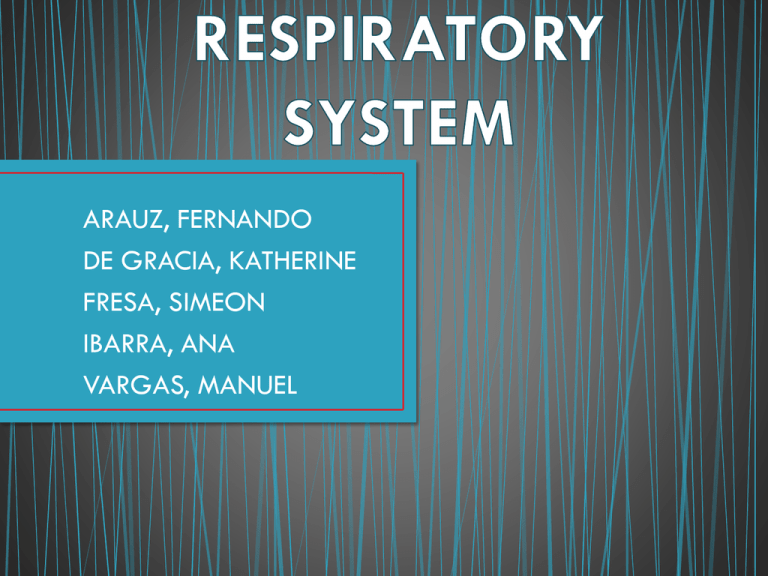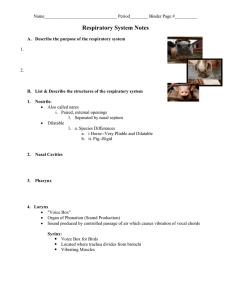ARAUZ, FERNANDO DE GRACIA, KATHERINE FRESA, SIMEON IBARRA, ANA
advertisement

ARAUZ, FERNANDO DE GRACIA, KATHERINE FRESA, SIMEON IBARRA, ANA VARGAS, MANUEL RESPIRATORY SYSTEM GENERALITIES RESPIRATORY TRACT UPPER TRACT LOWER TRACT SPECIFIC FUNCTIONS MECHANISM OF BREATHING RESPIRATORY DISEASES 1. WHAT IS THE RESPIRATORY SYSTEM? 2. WHICH ORGANS COMPOSE IT? 3. WHICH IS THE MAIN FUNCTION OF THE RESPIRATORY SYSTEM? RESPYRATORY SYSTEM 1. 2. DEFINITION AND FAST VIEW RESPIRATORY TRACT´S ANATOMY a) b) 3. SPECIFIC FUNCTIONS a) b) c) d) e) 4. GAS EXCHANGE VOCALIZATION DEFENSE EXCRETION pH REGULATION PULMONARY VENTILATION a) b) 5. UPER TRACT LOWER TRACT EXTERNAL RESPIRATION INTERNAL RESPIRATION RESPIRATORY DISEASES a) b) c) d) e) COMMON COLD RHINITIS PHARYNGITIS PNEUMONIA ASTHMA Upper Respiratory Tract Structure Functions Nasal cavity Pharynx Larynx Functions Anatomy Anatomy Anatomy Interesting facts Functions Structure upper lower Function Driving area (filter, heat, humidify the air and brings it to the lungs) Respiratory tract (tissue inside the lungs where gas exchange occurs Function 1: produce mucus Resonance chambers for sound when we talk. Function 2: Heating, humidification and filtration of inhaled air. Coated with skeletal muscle and mucosa Funnel shaped canal. • 13 cm long • Through passage of air and food It is divided into three regions: nasopharynx oropharynx and laryngopharynx The most important arytenoid (influence changes in position and tension of the vocal folds). Connect the laryngopharynx to the trachea. Made up of 9 pieces of cartilage ALVEOLUS TRACHEA BRONCHEOLES LUNGS BRONCHI LARYNX 20 HIALINE CARTILAGE RINGS 2- 2.5 cm DIAMETER TRACHEA CARRYING AIR BRONCHI 10-11 cm LENGTH 1. Trachea 2. Main bronchus 3. Lobar bronchus 4. Segmental bronchus 5. Bronchiole 6. Alveolar duct 7. Alveolus ESSENTIAL RESPIRATORY ORGAN 2 TISSUE SACS LUNGS THE RIGTH IS BIGGER THAN LEFT TRANSPORT OXYGEN FROM THE ATMOSPHERE 2 LOBES MEDIASTINE 3 LOBES TO INCREASE THE EXCHANGE AREA ELASTIC FIBERS IT ARE CONNECTED TO ALVEOLAR CONDUCT HERE TAKE PLACE THE GAS EXCHANGE 1) Gas exchange 2) Vocalization 3) Excretion 4) Defense 5) pH regulation 1) It provides oxygen to the bloodstream and removes carbon dioxide 2) It enables sound production or vocalization as expired air passes over the vocal cords. 3) It assists in abdominal compression during urination, defecation, and childbirth. 4) It enables protective barriers, like the coughing and sneezing, to keep the air ways free of strange agents. 5) CO2 reacts with H2O into the organism to become bicarbonate which prevents a state of acidosis in the body. Pulmonary Ventilation Internal respiration External respiration Gas Transport • The air should enter and exit to the lung. • Is a mechanical process. • Is renamed respiration Back • Gas exchange take place to between to alveoli and pulmonary blood What happens? Differences • Carbon dioxide: dark red blood • Oxygen: scarlet river • Oxygen uptake by hemoglobin Back oxygen and carbon dioxide travel through the blood Gas transport oxygen binds to hemoglobin mo lecules, carbon dioxide is transported in plasma as bicarbonate ion Back gas exchange must be made between blood and tissue cells. Back COLD Symptoms Rhinitis Infectious Nonallergic Allergic Acute and chronic bacterial infection Runny nose that is not due to allegy Allergy by polen, animal dander, dust, etc Rhinorrhea, cough, congestion, headache Inflammatory Non-inflammatory Itching, swelling, mucus production Associated with Infectious agents Typical symptoms Typical symptoms Treatment





